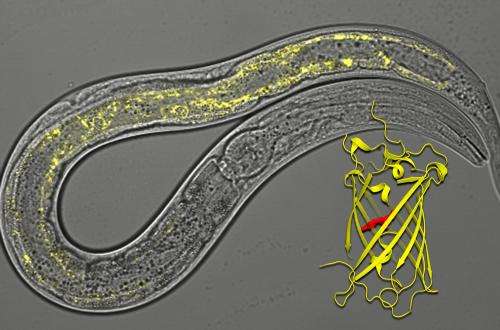Cause of ageing remains elusive

A report by Chinese researchers in the journal Nature a few months ago was a small sensation: they appeared to have found the cause for why organisms age. An international team of scientists, headed by the University of Bonn, has now refuted a basic assumption of the Nature article. The reasons for ageing thus remain elusive.
The Chinese article caused a stir amongst experts worldwide. Using a simple measurement in young nematode worms, the researchers reported they had been able to predict how long they would live .
The researchers had introduced a fluorescent probe called cpYFP into the cellular power stations, the mitochondria, of the worms. Mitochondria are present in most living organisms. They provide the energy for all processes of life.
Many biologists consider the mitochondria an important biological clock that drives ageing. As an underlying cause they suspect that the highly reactive molecules, so called free radicals, released during energy conversion by the power stations can react with cellular molecules causing damage. As a result cellular performance decreases until the cell dies.
This theory is not new – it was first proposed nearly 40 years ago. However, until today it has not been possible to show a conclusive link between mitochondrial activity, the formation of free radicals and ageing. En-Zhi Shen and his colleagues appeared to have found a critical link. They used cpYFP as a free radical detector. And indeed: the more frequently the probe lit up in young worms - i.e. the more free radicals they appeared to produce -, the shorter the worms lived.
An international team of scientists has now refuted a basic assumption of this study. Their work shows that cpYFP is not able to measure free radicals in the first place. Instead the signals of the probe are the result of changes in pH (that is the acidity) inside the mitochondria.
"From the published worm data we cannot conclude that the degree of free radical release determines lifespan." says Dr. Markus Schwarzländer, research group leader at the University of Bonn and first author of the publication. "cpYFP is not suitable to address this question." He adds that the relationship between the occurance of the probe signals and lifespan of the worms was exciting nevertheless. "Now we can focus on trying to understand its actual significance."
The new study is soon to appear, also in the journal Nature. 28 experts from 9 countries were involved in this work. It was led by scientists from the University of Bonn, from the German Cancer Research Center Heidelberg, as well as from the Medical Research Council in Cambridge, England.
More information: Markus Schwarzländer et al.: The 'mitoflash' probe cpYFP does not respond to superoxide; Nature Band 514, Ausgabe 7523; DOI: 10.1038/nature13858

















